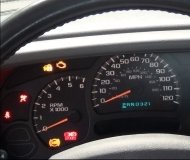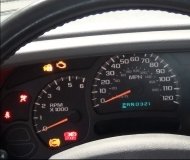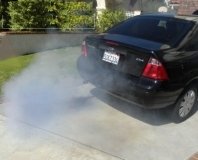I would start by checking/replacing TPS (throttle position) sensor
Fuel Pump Module (FPM)
Electrically driven FPM is located inside fuel tank. Normally aspirated 4.0L 6-Cyl. Engine is equipped with one FPM. Supercharged 4.0L 6-Cyl. Is equipped with 2 FPMs. FPM delivers fuel to solenoid-operated fuel injectors, while fuel pressure is controlled by fuel pressure regulator.
Fuel Pressure Regulator
Fuel pressure regulator is mounted on fuel rail. Actual (regulated) fuel pressure varies between 35-45 psi (2.5-3.2 kg/cm2 ) depending on intake manifold vacuum acting on fuel pressure regulator diaphragm. By maintaining constant fuel pressure, quantity of fuel injected for a given duration of injector on time remains constant.
Inertia Fuel Shutoff Switch (IFSS)
IFSS is located on passenger's side footwell on front door pillar. Switch is an inertia-actuated safety device which de-energizes ignition on relay, inhibits fuel pump module operation, and activates central locking system to open all door locks should the vehicle be subjected to a heavy impact force.
FUEL CONTROL
Air/Fuel Ratio Corrections
Using heated oxygen sensor input signal, ECM maintains air/fuel ratio at approximately 14.7:1. Secondary air is also introduced into exhaust system by the relay-activated air injection pump. ECM-controlled air injection time varies from a few minutes (cold engine) to a few seconds (hot engine).
After-Start Enrichment
ECM increases injector on time based on input signals received from engine coolant temperature sensor. After-start enrichment is maintained based on warm-up parameters. Short injector on times are used when engine is hot. Longer injector on times are used during cold starts.
Cranking Enrichment
This coolant temperature-based enrichment provides an appropriate amount of fuel when starter motor is activated. Cranking enrichment is achieved by increasing injector operating frequency (injector on time) from one pulse to 3 pulses per crankshaft revolution. Cranking enrichment ends when engine speed reaches 250 RPM at coolant temperature more than 107 °F (42 °C), or 500 RPM at coolant temperature less than 107 °F (42 °C).
Demand (Engine Load) Corrections
Demand corrections are provided during idle, acceleration, and full throttle demands. Corrections are achieved by increasing injector on time above basic requirements and is implemented by ECM based on input signals from throttle position sensor
Thursday, December 31st, 2009 AT 8:39 AM



